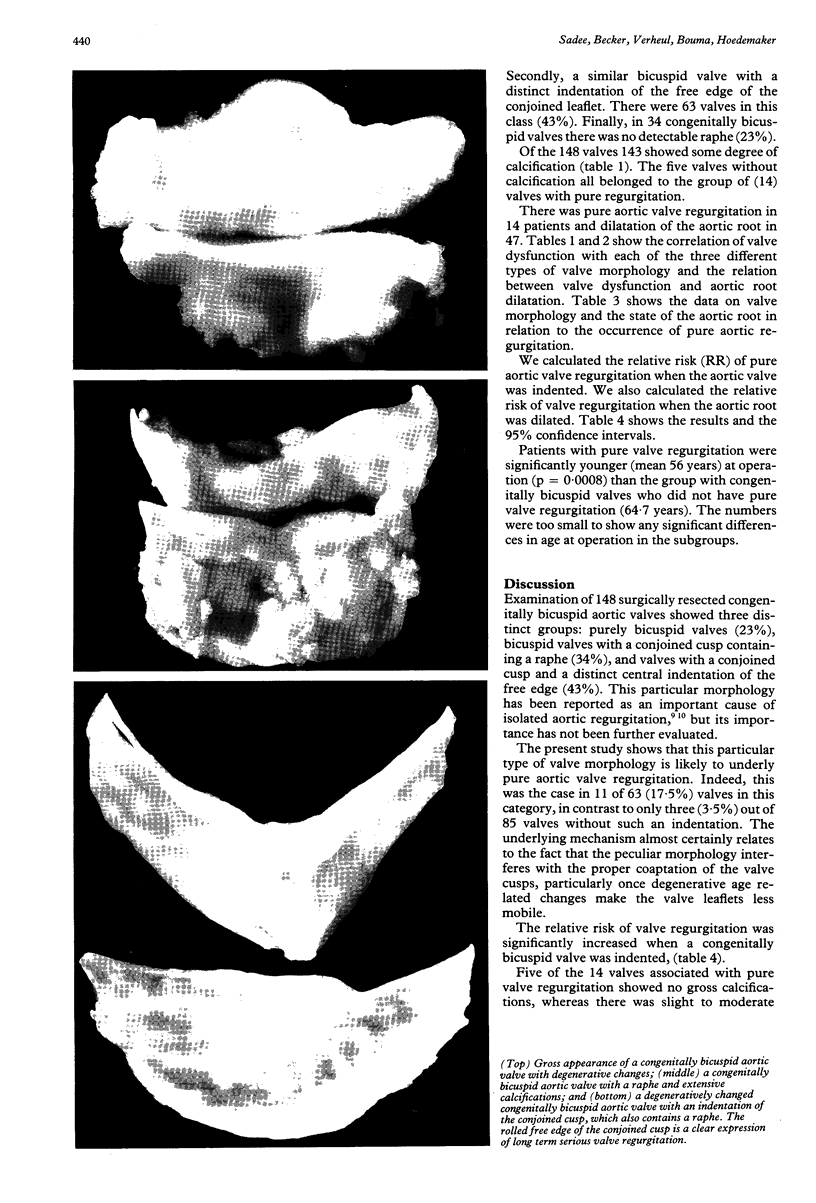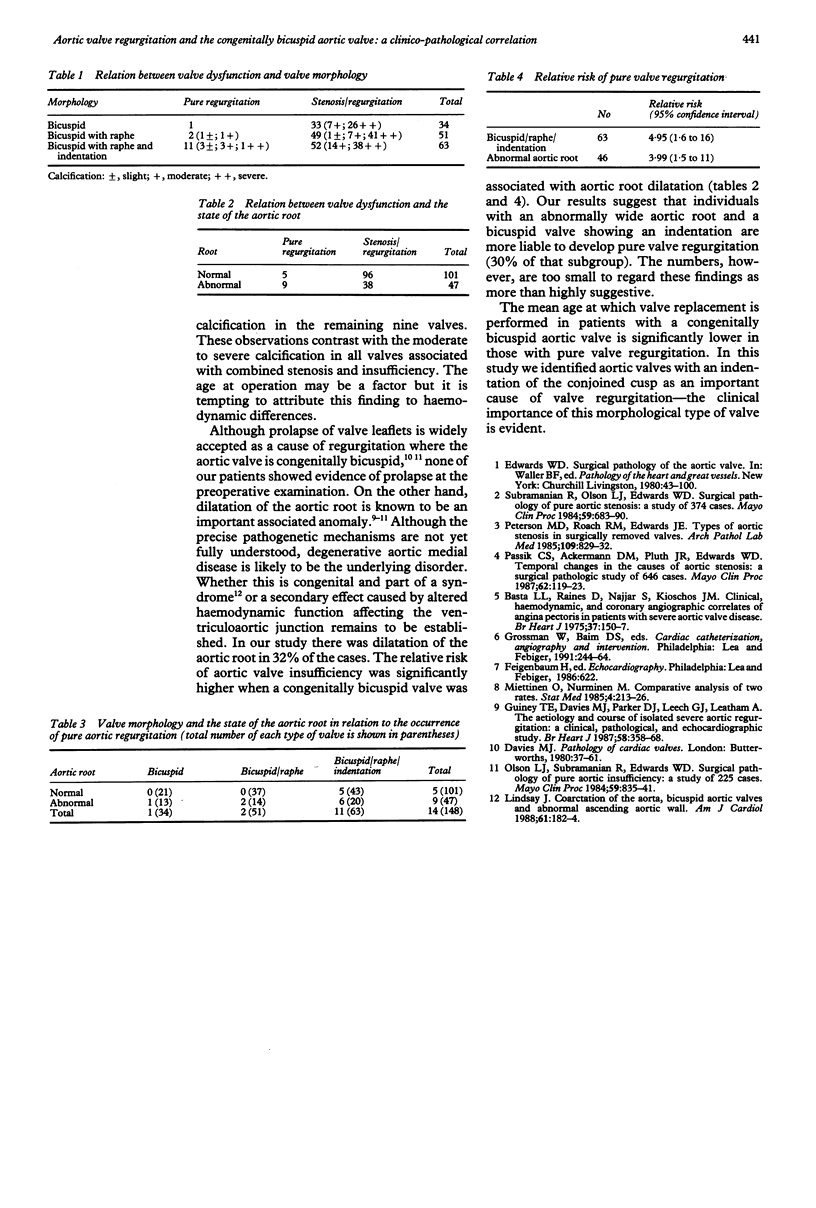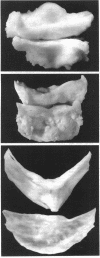Abstract
OBJECTIVE--To investigate the morphology of congenitally bicuspid aortic valves causing pure valve regurgitation. DESIGN--A case series collected over five years. SETTING--An academic hospital. PATIENTS AND METHODS--One hundred and forty eight excised congenitally bicuspid aortic valves. The morphological findings were correlated with sex, age, clinical history, and data on haemodynamic function before operation. Pure valve regurgitation was defined as grade 3-4/4 with a gradient less than 30 mm Hg. Aortic root dilatation was evaluated angiographically or echocardiographically or both. RESULTS--Three types were recognised: valves that were purely bicuspid (23%), bicuspid valves with a raphe (34%), and valves with an additional indentation of the free edge of the conjoined cusp (43%). In 14 cases pure valve regurgitation was present. Dilatation of the aortic root was present in 47 cases. The relative risk for regurgitation when the aortic root was dilated (compared with no dilatation) was 3.99. The relative risk for valve regurgitation when there was indentation of the conjoined cusp (compared with no indentation) was 4.95. The mean age at operation in patients with pure regurgitation was 56 years, which is significantly younger (p = 0.0008) than that of patients with a congenitally bicuspid valve with combined valve stenosis and regurgitation (64.7 years). CONCLUSIONS--Congenitally bicuspid aortic valves with a central indentation of the free edge of the conjoined cusp seem particularly likely to develop pure aortic valve regurgitation.
Full text
PDF


Images in this article
Selected References
These references are in PubMed. This may not be the complete list of references from this article.
- Basta L. L., Raines D., Najjar S., Kioschos J. M. Clinical, haemodynamic, and coronary angiographic correlates of angina pectoris in patients with severe aortic valve disease. Br Heart J. 1975 Feb;37(2):150–157. doi: 10.1136/hrt.37.2.150. [DOI] [PMC free article] [PubMed] [Google Scholar]
- Guiney T. E., Davies M. J., Parker D. J., Leech G. J., Leatham A. The aetiology and course of isolated severe aortic regurgitation: a clinical, pathological, and echocardiographic study. Br Heart J. 1987 Oct;58(4):358–368. doi: 10.1136/hrt.58.4.358. [DOI] [PMC free article] [PubMed] [Google Scholar]
- Lindsay J., Jr Coarctation of the aorta, bicuspid aortic valve and abnormal ascending aortic wall. Am J Cardiol. 1988 Jan 1;61(1):182–184. doi: 10.1016/0002-9149(88)91327-6. [DOI] [PubMed] [Google Scholar]
- Miettinen O., Nurminen M. Comparative analysis of two rates. Stat Med. 1985 Apr-Jun;4(2):213–226. doi: 10.1002/sim.4780040211. [DOI] [PubMed] [Google Scholar]
- Olson L. J., Subramanian R., Edwards W. D. Surgical pathology of pure aortic insufficiency: a study of 225 cases. Mayo Clin Proc. 1984 Dec;59(12):835–841. doi: 10.1016/s0025-6196(12)65618-3. [DOI] [PubMed] [Google Scholar]
- Passik C. S., Ackermann D. M., Pluth J. R., Edwards W. D. Temporal changes in the causes of aortic stenosis: a surgical pathologic study of 646 cases. Mayo Clin Proc. 1987 Feb;62(2):119–123. doi: 10.1016/s0025-6196(12)61880-1. [DOI] [PubMed] [Google Scholar]
- Peterson M. D., Roach R. M., Edwards J. E. Types of aortic stenosis in surgically removed valves. Arch Pathol Lab Med. 1985 Sep;109(9):829–832. [PubMed] [Google Scholar]
- Subramanian R., Olson L. J., Edwards W. D. Surgical pathology of pure aortic stenosis: a study of 374 cases. Mayo Clin Proc. 1984 Oct;59(10):683–690. doi: 10.1016/s0025-6196(12)62057-6. [DOI] [PubMed] [Google Scholar]



